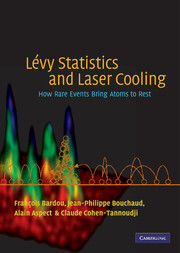Book contents
- Frontmatter
- Contents
- Foreword
- Acknowledgements
- 1 Introduction
- 2 Subrecoil laser cooling and anomalous random walks
- 3 Trapping and recycling. Statistical properties
- 4 Broad distributions and Lévy statistics: a brief overview
- 5 The proportion of atoms trapped in quasi-dark states
- 6 The momentum distribution
- 7 Physical discussion
- 8 Tests of the statistical approach
- 9 Example of application: optimization of the peak of cooled atoms
- 10 Conclusion
- Appendix A Correspondence between parameters of the statistical models and atomic and laser parameters
- Appendix B The Doppler case
- Appendix C The special case µ = 1
- References
- Index of main notation
- Index
4 - Broad distributions and Lévy statistics: a brief overview
Published online by Cambridge University Press: 06 July 2010
- Frontmatter
- Contents
- Foreword
- Acknowledgements
- 1 Introduction
- 2 Subrecoil laser cooling and anomalous random walks
- 3 Trapping and recycling. Statistical properties
- 4 Broad distributions and Lévy statistics: a brief overview
- 5 The proportion of atoms trapped in quasi-dark states
- 6 The momentum distribution
- 7 Physical discussion
- 8 Tests of the statistical approach
- 9 Example of application: optimization of the peak of cooled atoms
- 10 Conclusion
- Appendix A Correspondence between parameters of the statistical models and atomic and laser parameters
- Appendix B The Doppler case
- Appendix C The special case µ = 1
- References
- Index of main notation
- Index
Summary
In this chapter, we introduce the main concepts and tools of Lévy statistics that will be used in subsequent chapters in the context of laser cooling. In Section 4.1, we show how statistical distributions with slowly decaying power-law tails can appear in a physical problem. Then, in Section 4.2, we introduce the generalized Central Limit Theorem enabling one to handle statistically ‘Lévy sums’, i.e. sums of independent random variables, the distributions of which have power-law tails. We also sketch, in a part that can be skipped at first reading, the proof of the theorem and present a few mathematical properties concerning distributions with power-law tails and Lévy distributions. In Section 4.3, we present some properties of Lévy sums which will turn out to be crucial for the physical discussion presented in subsequent chapters: the scaling behaviour, the hierarchy and fluctuation problems. These properties are illustrated using numerical simulations. Finally, in Section 4.4, we present the distribution S(t), called the ‘sprinkling distribution’. This distribution presents unexpected features and will play an essential role in the following chapters.
Power-law distributions. When do they occur?
Situations where broad distributions appear and where rare events play a dominant role are more and more frequently encountered in physics, as well as in many other fields, such as geology, economy and finance. The term ‘broad distributions’ usually refers to distributions decaying very slowly for large deviations, typically as a power law, implying that some moments of the distribution are formally infinite.
- Type
- Chapter
- Information
- Lévy Statistics and Laser CoolingHow Rare Events Bring Atoms to Rest, pp. 42 - 59Publisher: Cambridge University PressPrint publication year: 2001



